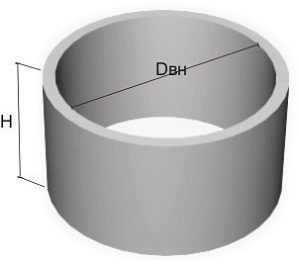Concrete rings serve good stuff for the manufacture of sewerage in private households. Septic tank from concrete rings allows organizing wastewater treatment up to 70%, but the percentage of treatment in it is lower than in high-tech biological stations (98%). If the territory does not belong to nature protection zones, then you can save on the sewage system, since the cost of such a septic tank is half the price of buying a treatment station.
Before starting work, it is necessary to determine the type of soil on the site. The choice of a filtration system depends on its characteristics, since the design of a septic tank from concrete rings involves several containers. According to sanitary standards, water must be subjected to three or more days of settling before being discharged into the ground.
The type of soil can be determined by digging a hole, interviewing neighbors who own a well or well, requesting information from an organization conducting construction or drilling near the site.
If the site is located in a hilly area, it is most likely of rocky soil. In this case, you need to make a choice in favor of ground treatment stations or storage tanks.
![]()
The clay throughput is practically zero. Soil of this type belongs to the category of waterproofing - water-repellent rocks that do not absorb and do not pass water through their thickness
The filtration coefficient is slightly higher for loams, slightly higher for sandy loams. However, their filtration properties are still not enough for the installation on the listed clay soils of systems of ground wastewater treatment.
In addition, almost all clay soils are characterized by heaving - the ability to increase in size during the freezing process and decrease during thawing. These ground movements can easily push concrete containers outward, completely destroy or simply squeeze them until cracks appear.
Sandy, gravel, pebble and gravelly sedimentary rocks have good absorbing properties. They freely pass water into their thickness, do not interfere with its movement into the underlying layers. True, coarse-grained deposits, such as gravel and pebbles, occur mainly in the floodplains of rivers, and rubble at the foot of mountain formations.
On river and mountain slopes, filtering facilities are not suitable, because part of the drainage liquid will not be able to pass a tertiary treatment cycle sufficient for disposal into the ground. Therefore, the normal conditions for the construction of filtration fields, absorption wells and the installation of infiltrators are sandy soils of all sizes and density of addition, except for silty soils.
In addition to geological conditions, it is necessary to comply with the norms of its location from residential buildings and water sources.

This information is spelled out in sanitary standards and must be observed. It is worth avoiding the location of the septic tank close to the place where the trees grow, as their root system can harm the structure
If neglected sanitary standards, biological contamination of the water may occur. Dangerous pathogens develop in sewage infectious diseases... These include E. coli, which causes severe poisoning. It easily gets to the source of drinking water through groundwater.
How to calculate the required volume
To organize a septic tank from concrete rings, it is necessary to calculate the volume based on the daily water consumption. According to the norms, one permanent resident has 200 cubic liters of water per day.
The first tank for settling wastewater should not have a volume of three times the consumption (200 liters) for each person. The second container with a bottom for settling should have a volume equal to 1/3 of the size of the first. The number of rings can be determined by dividing the volume of the container by the volume of the ring. They are small, medium and large in size.
![]()
For the calculation, the parameters of the medium-sized ring will be used. KS-10-9 with an inner diameter of 1 m and a height of 90. One ring has a volume of 700 cubic liters
For a family of two:
The volume of the first container \u003d (200 * 2) * 3 \u003d 1200 cubic liters.
The volume of the second and third containers \u003d 1200/3 \u003d 400 cubic liters.
Number of rings for two containers \u003d (1200 + 400) / 700 \u003d 4
Number of rings for three containers \u003d (1200 + 400 + 400) / 700 \u003d 5
2 rings for the sump, 2 for the sedimentation tank and one for the sump
For a family of three:
The volume of the first container \u003d (200 * 3) * 3 \u003d 1,800 cubic liters.
The volume of the second and third containers \u003d 1,800 / 3 \u003d 600 cubic liters.
Number of rings for two containers \u003d (1 800 + 600) / 700 \u003d 4
Number of rings for three containers \u003d (1800 + 1200) / 700 \u003d 6.
2 rings for the sump, 2 for the sedimentation tank and two for the sump.
Types of septic systems
Schemes of septic tanks made of concrete rings imply the presence of one, two or three chambers, where the effluent settles and their biological processing takes place.

A single-chamber septic tank provides a three-day settling of waste water. It requires pumping out excess sludge every 3-6 months. Cleaning quality does not exceed 50% (+)
In fact, single chamber septic tank is an ordinary storage tank, from which wastewater is pumped out by flushers.
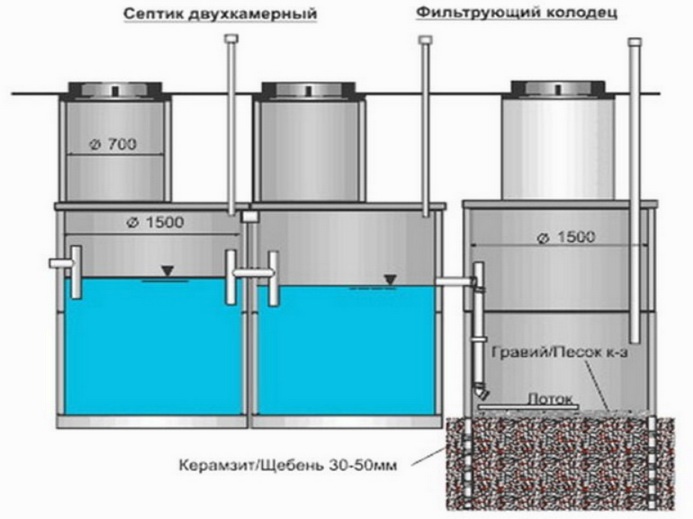
A two-chamber septic tank provides 5-6 days of settling of effluents. The cleaning level is 70%. It is necessary to pump out excess sludge every 12 months.
The first and second containers must have a bottom. This is followed by the third compartment, where soil cleaning is also carried out. The next stage of purification is the withdrawal of excess runoff into the ground through the bottom of the filter well.

The three-chamber septic tank provides 7-9 days of settling of effluents. The cleaning level is 80%. It is necessary to pump out excess sludge every 2 years (+)
All chambers are arranged with a monolithic bottom, cleaning is carried out by settling. The settled liquid is discharged into an infiltrator or filtration field for subsequent disposal into the ground.
Depending on the absorption capacity of the soil, you can choose several filtration options for the device of a septic tank made of concrete rings:
- Septic system with filtering field.
- Septic system with a drainage well.
- Septic system with filter cassette (infiltrator).
The most common filtration option is a drainage well. It is used with good soil absorption properties.

To increase productivity, its bottom ring is perforated. This increases the filtration area. If the level groundwater is less than three meters, this option must be discarded (+)
Between the level of the conditional bottom of the absorption well and the highest level of groundwater in the autumn / spring rainy period, there is no meter required by the standards, a filtration field is established. There must be enough space on the site for its construction.
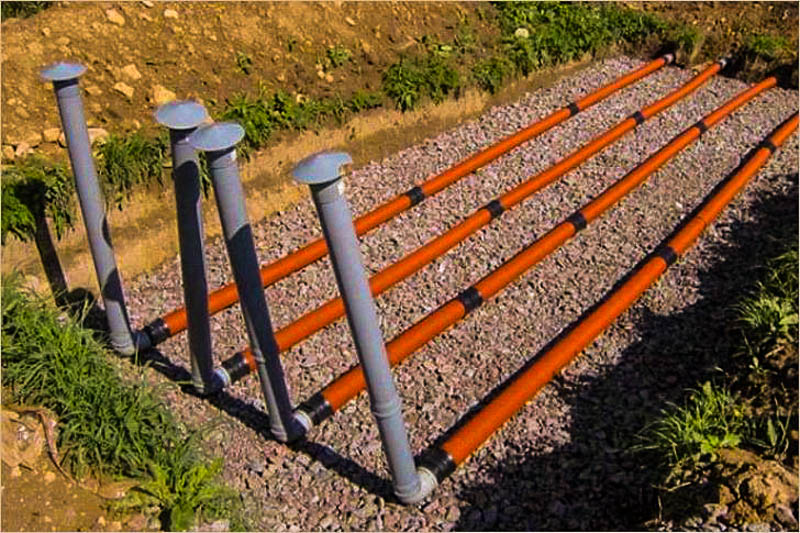
During its installation, perforated pipes or tunnels are used. For even distribution of wastewater between the septic tank and the filtration field, a distribution well is installed.
it optimal solution for areas where the groundwater level does not exceed 2.5 meters. It should be remembered that between the bottom edge of the drainage pipes of the filtration field and the top of the water-saturated layer, there must also be a soil thickness of at least one meter.
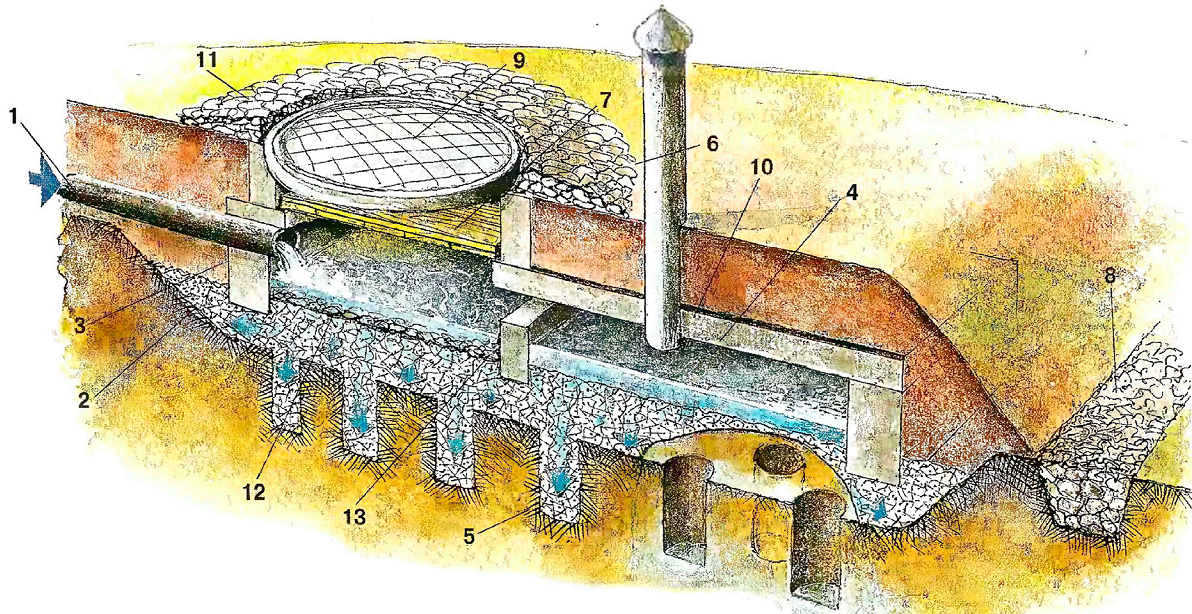
The filter cassette is analogous to the filtration field, but it is more expensive. This is the middle between the filter well and the aeration pipe system. It consists of a rectangular concrete tank with several partitions inside. The structure is closed from above with concrete slabs (+)
This design is not widespread in the CIS countries.
You need to decide on the filtration system before installing a septic tank from concrete rings, as this will allow you to prepare a pit of the required size and depth in advance. Installing filtration systems after installation can damage pipes and reservoirs. Therefore, the space that borders the wall of the second sedimentation tank will have to be dug manually, without the use of special equipment.
Installation of a septic tank with two sedimentation tanks
Before starting work, it is necessary to check the groundwater level. This can be done if the house has a cellar or basement without a concrete bottom. It is necessary to measure the height from the ceiling to the surface layer of the soil. This is the depth to which you can dig.
To find out how deep the groundwater is, you can dig a small but deep hole. Groundwater begins when clearly damp earth appears. This is a sure sign, you don't need to dig further.
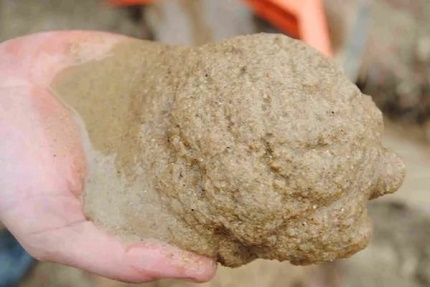
The depth of the appearance of groundwater can be determined by the appearance of the soil extracted from the pit. If it is saturated with water, then the depth of its extraction can be taken as an independently determined GWL
After the approximate GVL has become known, you can proceed to earthworks... It is necessary to outline the place where the septic tank will be located. To do this, you need to outline the pits. To do this, you need to take a construction or any strong thread, measure 80 cm. Tie two pegs to both ends.
Stick one end in the middle of the place where you plan to place the first settling tank. Draw a circle. This is the approximate diameter of the desired hole. Next, you need to step back a meter, and draw the boundaries for the second container. Next, you need to outline the boundaries of the filtration structure.
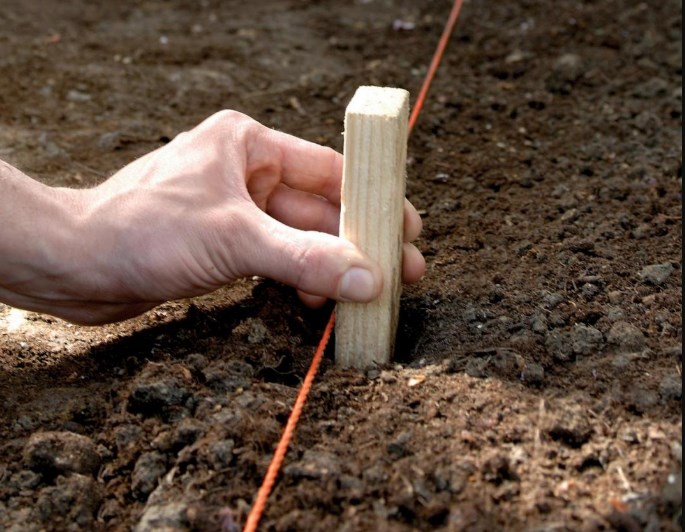
The boundaries of the pit must be surrounded by pegs around the perimeter, between which to pull the thread. It's easier to navigate when digging
Consumables and tools
Before you start, you need to collect all the necessary materials and tools. For work you will need:
- hammer drill and a large drill for concrete;
- mixer nozzle for perforator;
- shovel and bayonet shovels;
- stairs;
- level:
- buckets;
- container for mixing the solution;
- durable nylon rope;
- hose;
Materials for mounting a septic tank from concrete rings:
- cement;
- sand;
- gravel;
- bitumen or liquid glass;
- metal staples;
- Mineral wool or expanded polystyrene;
After the equipment for all stages of work has been selected and prepared, you can start digging a hole.
How to dig pits for a septic tank
If you think that it is difficult to excavate soil in such volumes manually, you can use the services of organizations that have special equipment.
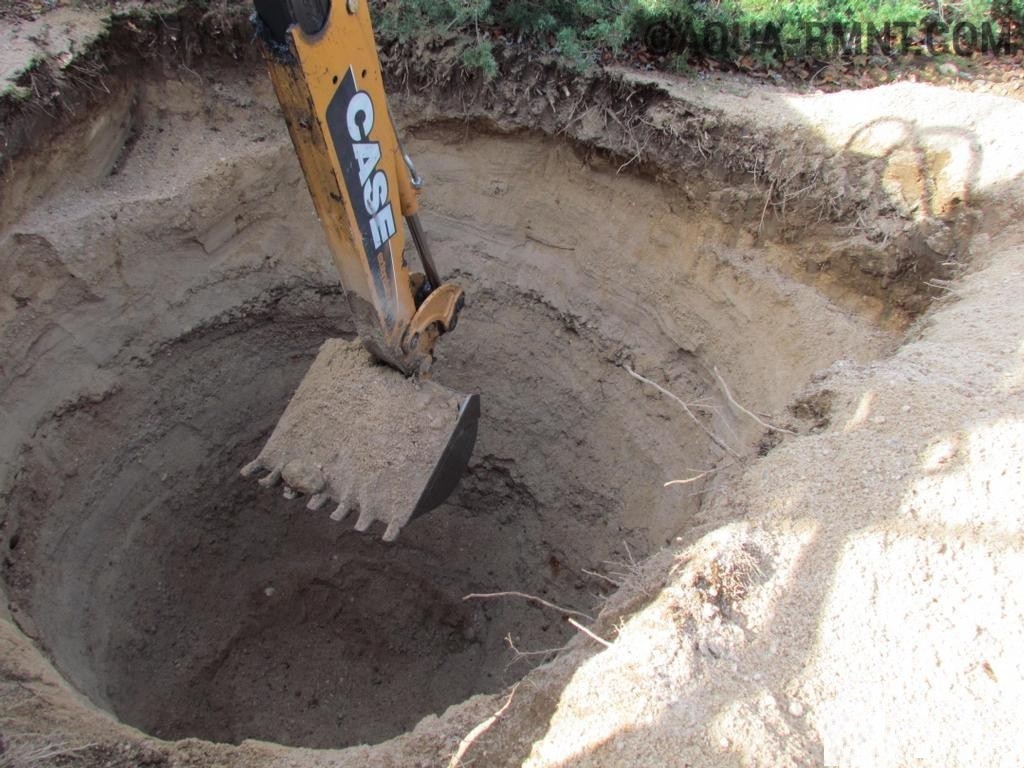
Together with the excavation of the pit, you need to order the removal of excess soil, since the deep layers are, as a rule, loam and are not suitable for use in garden plots.
Sand must be poured at the bottom of the pit, where the lower rings of the tanks will be installed. Thickness sand pillow is 20-25 cm. The base must be leveled. Next, the sand must be spilled with water so that shrinkage occurs. After pressing sandy base you can proceed to the installation of the rings.
Installation of sedimentation tanks
To install the concrete rings for the septic tank that were previously brought to the site, you need to build a base. To do this, along the perimeter of the bottom of the pit, wooden formwork... The height of the walls of the formwork should be at the level of 30-40 cm. After the construction of the formwork, it is necessary to lay the reinforcing mesh and dilute the cement mortar. To do this, you need to take 1 part of cement for three parts of ASG (a mixture of sand and gravel).
You can mix the solution using a construction mixer. You can add two tablespoons of liquid soap to the solution as a plasticizer. This will make the concrete more resistant to pressure and moisture. After pouring the base, you need to wait 10 - 14 days until the solution hardens and acquires the required strength. The formwork does not need to be removed. If rented equipment is used, it is more advisable to purchase ready-made concrete slabs as a base.
After the base is ready, you can mount the rings. The weight of the concrete structures is impressive, so a crane must be used. Installation of containers takes place in stages.
On concrete base immerse the first ring. Following it, the second is lowered and installed. The ring must be moved evenly, avoiding hitting or slipping. After installation, scraping is done.

Holes are made in both rings at the edges, iron brackets are inserted into them, which are bent from the outer sides of the containers
In the next step, until the lid is lowered, it is necessary to cover the seams between the rings. After installing the overlap, it will become dark in the container and there is a risk of leaving untreated joints. For this, cement mortar is used. For ease of movement, running brackets are mounted inside the container. They are necessary for servicing the septic tank, in case of blockages or depressurization.
The adjacent settling tank is installed in the same order. In both containers it is necessary to make holes for the sewer pipes and install them. The sewer inlet must be located higher than the overflow pipe between the tanks.

On top of the ceilings, one concrete ring of small diameter must be installed. Thus, a small chamber is obtained, which will isolate the container from the ingress of cold air.
This completes the installation of a septic tank from concrete rings, and the installation of a ventilation system follows.
Ventilation system installation
Ventilation is necessary to allow air to enter the system, which ensures the normal functioning of microorganisms. They process domestic waste water and free it from organic matter. To ensure constant air circulation, two ventilation pipes are required.
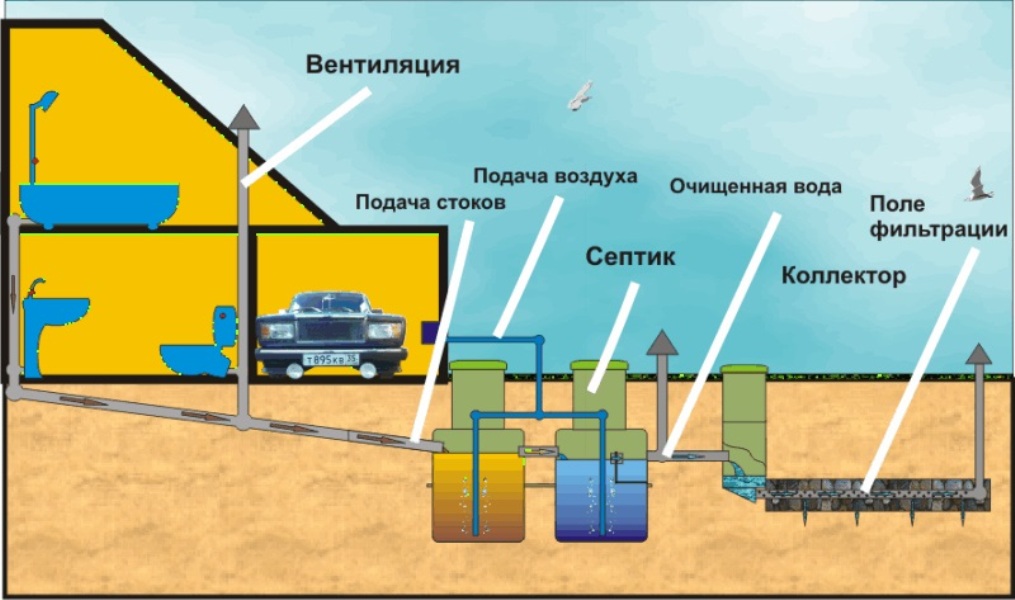
The first pipe is installed in the section sewer pipe, which is as close as possible to the walls of the residential building. The best solution would be to mount it from the inside of the wall, but you can also mount it outside (+)
In this case, you will have to lay an electric cable to warm the pipe, since when warm and cold air collide, condensation forms in it, which blocks the access of oxygen. It must be fixed with fasteners or clamps. The length of the vertical background riser must be at least the height of the house wall.
Ventilation also removes unpleasant odors that occasionally appear from containers and can spread throughout the house. This often happens when there is a prolonged absence of residents and the liquid in the siphon dries out.
The second pipe is mounted in the overlap of the sedimentation tank. To do this, using a perforator, a hole is punched in the ceiling, which coincides in diameter with the ventilation pipe. The air duct should rise 70-100 cm above the earth's surface. The position of this pipe will be fixed by the weight of the soil and does not need additional fastening.
Installation of aeration field
From the second concrete tank, a pipe emerges into a distribution well. For the well, you can use a plastic barrel, in which you can cut holes suitable for aeration pipes.
You can purchase a ready-made distribution well.
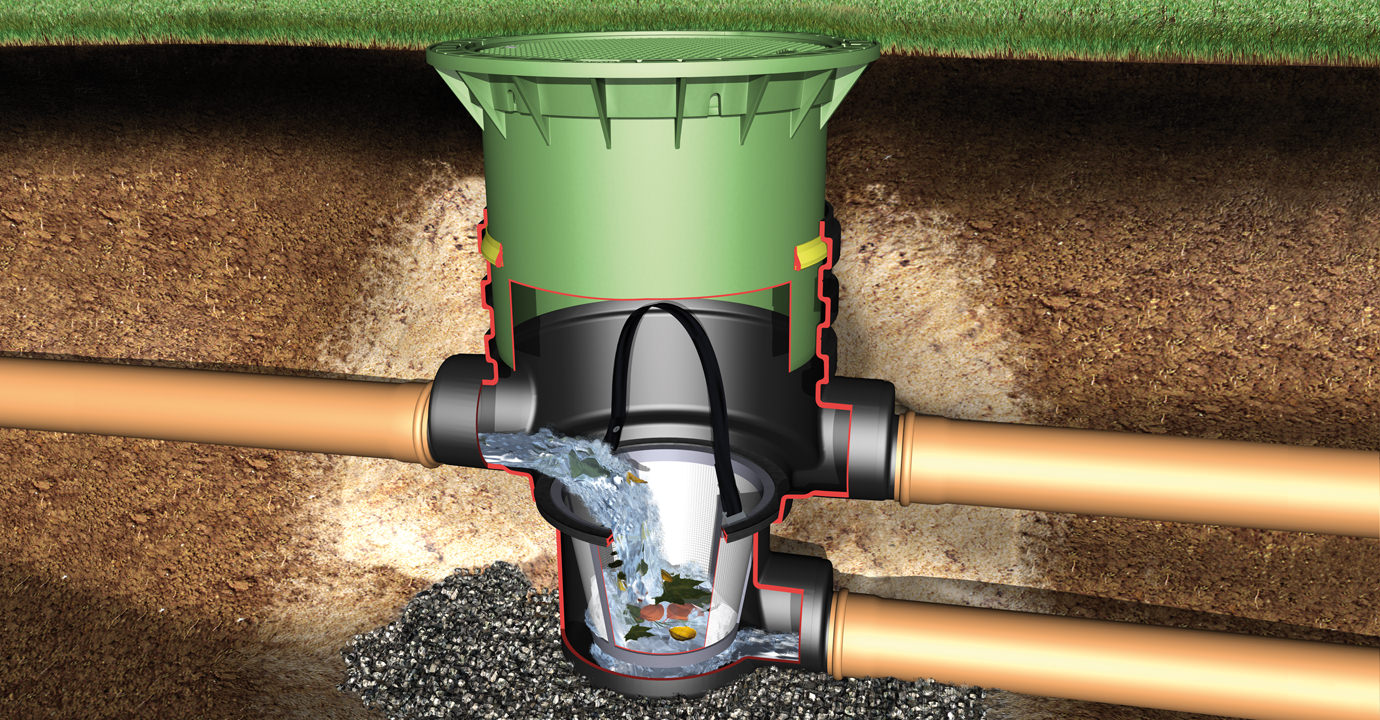
It is produced by many companies that manufacture cleaning systems. You can buy a ready-made aeration field for the distribution well or make it yourself from sewer pipes
To do this, you need to purchase pipes based on the size of the field. For a family of four, there is enough space 20 square meters (10 × 2). This will require three pipes 10 m long. In addition, you will need three corner pipes, where the ventilation pipes will be installed.
The field is pre-filled with sand and gravel to improve the absorption capacity of the soil.
Perforated pipes connected to a distribution well are laid on the prepared drainage. At the ends of the aeration pipes, corner pipes are mounted into which the background riser is installed, one for each pipe. After that, the pipes are covered with geotextiles and covered with a mixture of gravel and sand, then leveled. As silting progresses, the aeration field must be moved or cleaned by changing the drainage.
Installation of a filter well
The filter well has a number of advantages over the aeration field. It takes up less usable area on the site. But the quality of the treated water will be higher in the aeration field, since before entering the groundwater, the drains will be filtered by soil, and its layer under the aeration field is much larger than that of a well with drainage. The area of \u200b\u200bthe well cannot cope with the amount of wastewater that the aeration section receives.
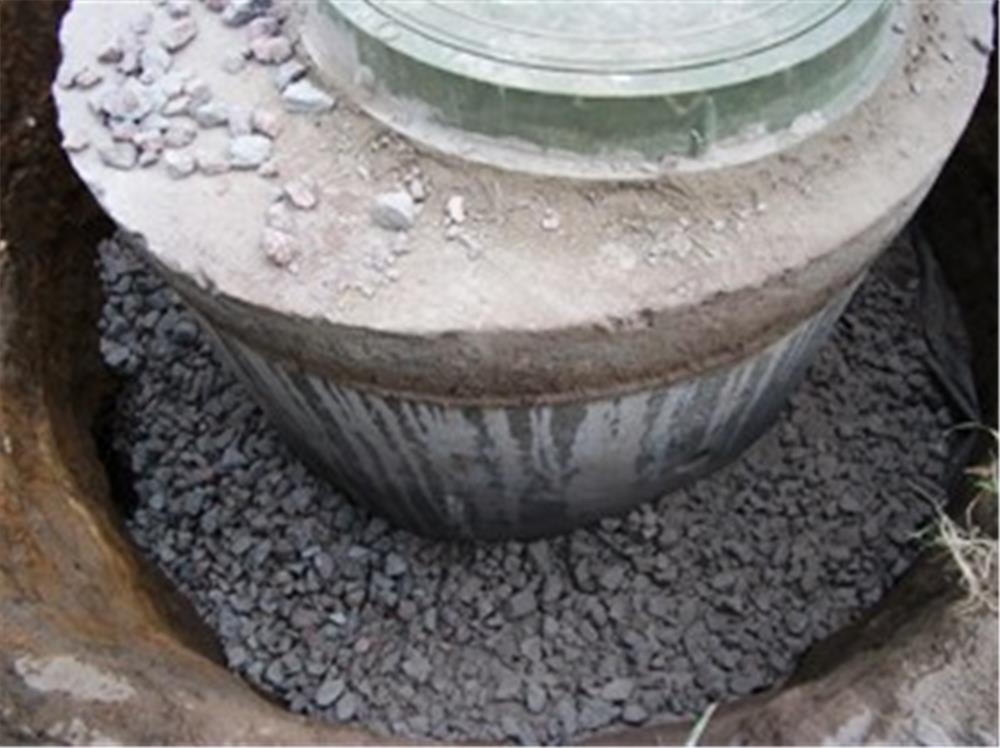
The filtration well must be located at a distance of at least 2 meters from the sedimentation tank. This is necessary in order to exclude soil movement and deformation of the foundation in the event of emergency leaks and flooding.
The installation of a well is based on the same principles as for sedimentation tanks, excluding concreting the bottom of the tank. At the bottom of the well, in addition to a sand cushion, you need to place crushed stone, gravel, or another filtering composition. The standard capacity of the soil filter in the absorption well is calculated from 1 m or more.
To increase it throughput, it is possible to supplement the filtration well with side drainage. For its construction, the lower concrete ring of the septic tank must be perforated.

You can find ring models that already contain holes, but they are difficult to find. Therefore, it is more advisable to independently make holes using a punch.
This process is best done on the surface, before the ring is lowered into the pit. You also need to make a hole for the overflow of water from the sedimentation tank, it should be located slightly lower than the previous overflow.
The walls and joints of the filter well must be stapled, but there is no need to seal them. By connecting the overflows, you can bury the structure. The first ring must be sprinkled with rubble from the outside, up to the junction with the second segment. The rest of the volume can be covered with soil from the backyard.
Launch preparation process
If the temperature in winter falls below 30 degrees, it is necessary to prepare insulation for the inner hatch cover. Since the container itself is located below the freezing level, it does not need additional insulation.
To insulate the lid, you need to take foam and cut out a circle that fits the diameter of the inner small concrete ring.

Polyfoam is practically not subject to decomposition and will last long yearsTo make it convenient to remove it to check the septic tank, you can make a hole in the middle where you can stick a nylon rope. From the back of the foam, the rope should be tied to a short and narrow board, and the other end should be left
Next, you need to cut out the cover itself. For this, ordinary plywood of sufficient strength is suitable. You can screw the door handle to it in order to make it convenient to open. Similarly, it is worth insulating the inner covers of the second sedimentation tank and drainage well.
Before using the septic tank, the first sedimentation tank must be filled with water to 1⁄4 of its volume. Pour a biological product into the filled container, which will help the septic tank to reach full capacity faster. After these steps, you must close the hatches.
Video how to install a septic tank
The video shows the installation process of a two-chamber septic tank in stages:
How the septic system works:
If the construction of a septic system from concrete rings is made in compliance with the rules, it will last for 20 years. We must not forget about the rules of operation and timely service. The pipes are made of plastic, so they can be easily damaged. It is strictly forbidden to park equipment or a car in the place where the tanks are located.
If everything is clear with the sewage system in the city, then what about its arrangement in the private sector or on summer cottage? Fortunately, there is a solution. You can build a septic tank. Moreover, it can be made of various materials. And the device of a septic tank made of concrete rings is considered one of the most popular technologies for creating this structure.
Design and principle of operation
A septic tank is a structure designed to treat sewage that is formed as a result of using a bath, a dishwasher and, of course, a toilet. It is a structure created from several tanks connected by pipes at a certain height so that water that has entered the septic tank can flow from one chamber to another. Typically, this structure has two or three chambers - their number often depends on the volume of flow. In this case, as a rule, one of the sections of the septic tank is a filtration well, where an additional cleaning process takes place and the liquid is removed into the environment.
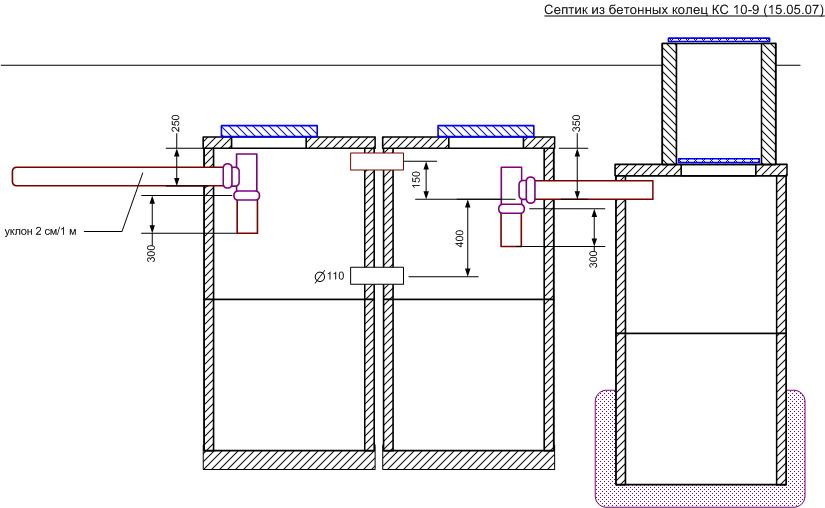
The principle of operation of a three-chamber septic tank is as follows: waste water, flowing through the drain sewer pipe, enters the first chamber, where the primary stage of cleaning takes place - large inclusions according to the laws of gravity begin to settle to the bottom of the tank. Further, as the chamber is filled, partially purified water passes through a pipe located at a certain level (but located lower than the inlet pipe) into the next chamber - a secondary settling tank. There it additionally settles; some of the lighter particles also have time to settle to the bottom.
On a note! Additionally, anaerobic bacteria can work on water purification in the second treatment chamber, which process pollutants. For them, this is the most favorite "delicacy".

The third chamber is a filtration well, in which, unlike the previous two, the bottom is not sealed, but through, but covered with sand and gravel. The liquid begins to seep and go into the ground, being additionally cleared in this layer. Such a septic tank, one might say, does not need, since the water independently goes into the soil layers. But still, once every few years, it is necessary to remove the sediment deposited at the bottom from it. To do this, they call the machines of the sewers.
The septic tank from two compartments works on the same principle, only the water after the first chamber immediately enters the drainage well and goes into the ground. By the way, additional soil purification can be carried out on filtration fields or with the help of biofilters, and not only in filter wells.

Why are septic tanks made of concrete rings good
One of the most common and inexpensive ways to build a septic tank with your own hands is to make it from concrete rings. There are such rings different sizes, and can also have additional parameters - a certain thickness, the presence of holes in the walls, etc. In addition to these products, round bottoms and covers are also produced, in which a hole is provided for installing a hatch.
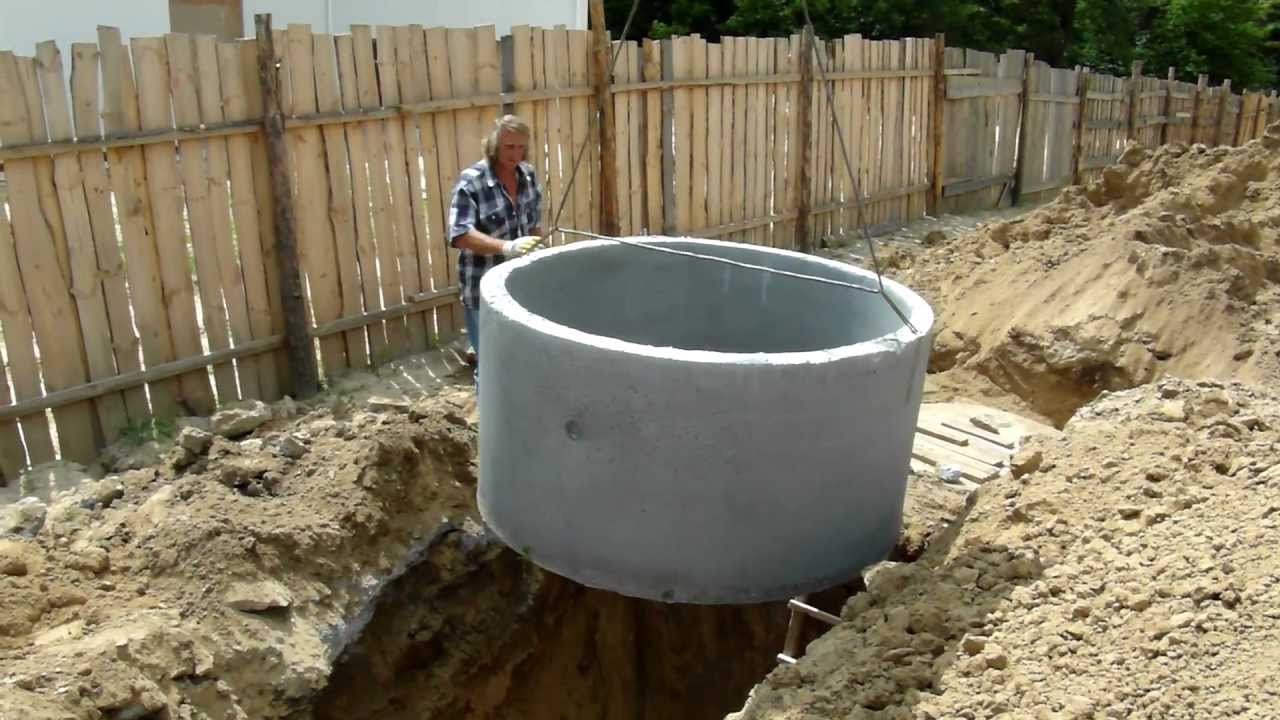
Table. Types of concrete rings.
| View | Characteristic |
|---|---|
| Such rings are also called complementary. They are only used in situations where the default rings are not suitable. Such designs are made to order. |
| Ideal for use in the installation of wells and other various communications. For example, drainage wells, water canals, gas pipelines and others are excellent from them. |
| During the construction of a septic tank, a neck can be formed from such rings. They are used for the manufacture of the upper part of all types of communications and wells. |
| Prefabricated, closed with a bottom, with ceilings, with a lock, etc. |
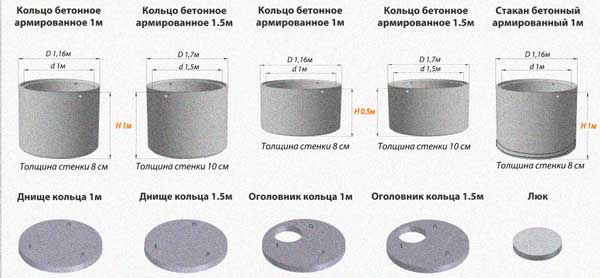
A septic tank made of concrete rings is a time-tested design. But you will have to sweat a lot during installation. Most likely, to install the rings in a pit prepared for a septic tank, you will have to call a special technique - a truck crane. It is very difficult to move such structures on your own - they have considerable weight. There are, of course, options for installing and digging in reinforced concrete rings into the ground without the use of technology, but the problem is that the ring itself is nevertheless rather fragile. Having dropped such an element even from a small height, it is easy to split it.
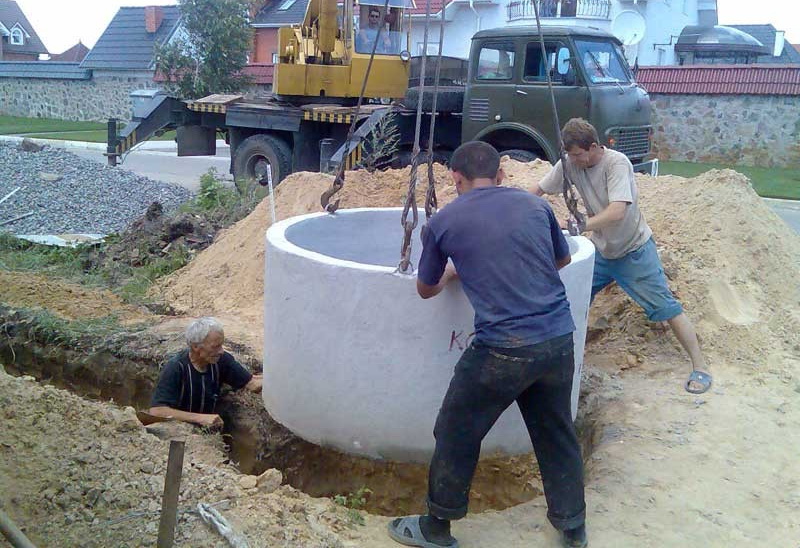
The disadvantage of using concrete rings as a basis for a septic tank is the need for large space. In a small area, such a design is unlikely to be implemented in compliance with all the rules and regulations. Also, when building a septic tank from concrete rings, great attention should be paid to sealing seams and joints.
The advantages of a septic tank made of reinforced concrete rings are as follows:
- these structures are not afraid of exposure to aggressive chemicals that enter the drain. And waste water itself is far from the most harmless composition;
- such a septic tank will not be afraid of temperature changes;
- the structure will perfectly cope with the unexpected flow of a large volume of water.
On a note! When choosing rings for a septic tank, it is best to stop at those that have fittings inside. Such rings are much stronger than ordinary concrete ones and will last as long as possible.

We calculate the sizes
Calculation of the dimensions of the future structure is an important point in the design of a structure. The parameters of the occupied space will directly depend on this, as well as the amount necessary materials... The first step is to calculate the volume of the septic tank, which depends on the volume of wastewater, which, in turn, depends on water consumption. On average, a person uses about 200 liters of water per day. This means that a family of three will spend 600 liters per day. However, the septic tank, according to the norms, should be three times as large. This means that it must contain at least 1800 m 3 of liquid.
Now it is necessary to calculate the internal volume of one concrete ring. It is easier to figure it out using the cylinder volume formula. it V \u003d 3.14 * D 3 * H / 4, where H is the height of the structure, D is its inner diameter, and V is the volume required for further calculations. Suppose the ring has a diameter of 1 m. Then its volume will be 0.79 m 3. In this case, the height of the ring does not need to be measured - this is a standard value and is equal to 1 m. Although sometimes there are rings with a height of 0.9 m on sale. Additional rings can be quite small in size.
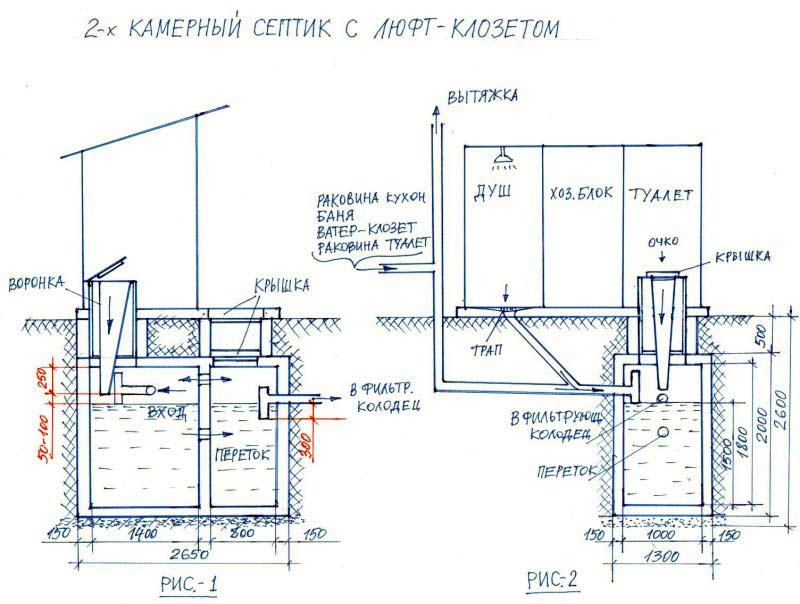
Attention! When calculations are made, it is important to remember that the last, upper ring should never be completely filled with liquid, but only 1/3. Thus, the working volume of the upper ring is 0.79 / 3 \u003d 0.26.
Based on the above calculations, you can also deduce the number of rings that you need to purchase. Thus, one section of the septic tank will need 3 rings. For the construction of a structure of three chambers, 9 reinforced concrete rings will be required.
Rings that are sold in stores usually have standard sizes and can be of different diameters - 70, 100, 120, 150, 200 cm.If the sewage system is to be built for a house where many people live, then it is better to use structures with a diameter of at least 100 cm.For small families, you can purchase rings of 70 cm. The larger the ring, the heavier it is, and therefore for the installation of a septic tank from products of 100 cm or more in diameter, you will definitely have to call a truck crane, since the mass of these rings varies between 700-900 kg.
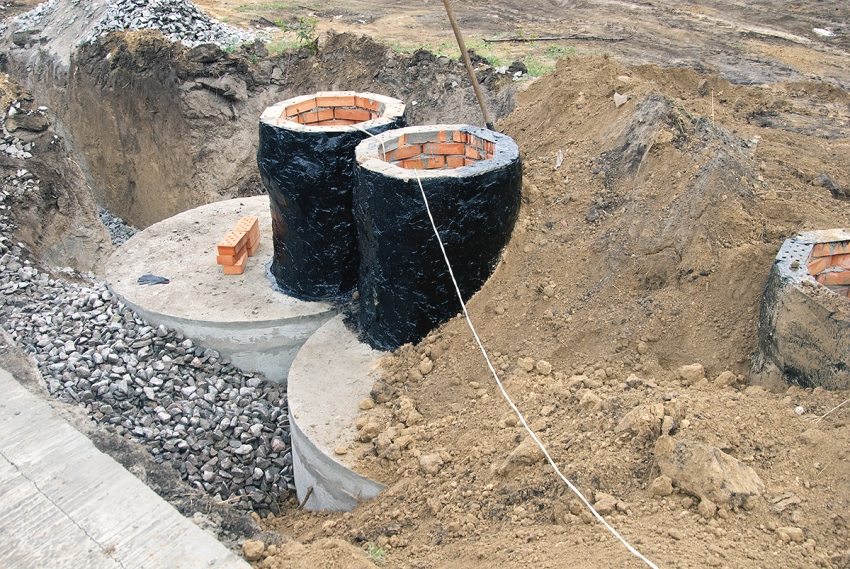
Advice! When calculating, it is worth remembering that the upper ring should protrude about 20-30 cm above the ground.
Septic tank volume calculator
Many residents country houses resort to the construction of a local treatment plant (septic tank) in the event that there are no centralized sewer networks... There are different types of septic tanks, ranging from finished factory products to homemade devices. In our article, we will focus on self-made sewage treatment plants, namely, the device of septic tanks from well rings. Most often they make a septic tank from concrete rings with their own hands for servicing a summer cottage or a small country house... In our article, we will consider the principle of operation of such structures, their varieties, and the device diagram. Videos and photos from the article will help you more clearly understand the process of building a septic tank from reinforced concrete rings.
Device diagram
The diagram of a product made from well rings can contain from 1 to 3 chambers made of reinforced concrete products. All chambers are connected to each other by overflow into a single structure. If you are going to make a treatment plant with your own hands, then the scheme of the future design should be developed taking into account the following factors:
- the volume of water consumption in the country or in a country house;
- terrain relief;
- the height of the groundwater table, as well as seasonal changes in this indicator;
- mark of soil freezing in your area;
- availability of free space for the entrance of construction equipment;
- compliance with regulatory gaps from surrounding buildings and wildlife.
Before arranging a septic tank for a summer residence, you need to determine its volume. It depends on the volume of water consumption by residents of the house during the day. The working volume of the treatment plant should be 3 times higher than the norm of water consumption per family. As a rule, it is assumed that 1 person consumes 200 liters of water per day. If this number is multiplied by three and by the number of people living in the house, then you will get the volume of the septic tank.
In such a counting scheme, the device of a septic tank is meant, consisting of two or more chambers. The working volume in this device is determined by the first chamber from the bottom to the overflow pipe.
Important: the actual capacity of the treatment plant may be slightly more than the calculated volume, but in no case less.
Principle of operation
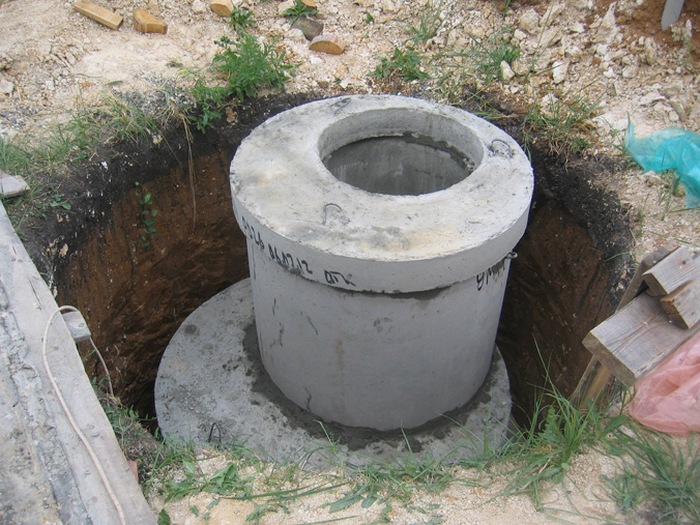
In a wastewater treatment plant, consisting of one chamber, a cumulative work scheme is used. Moreover, the larger the chamber, the less often the sludge will have to be pumped out.
In septic tanks, consisting of two or more chambers, the principle of operation is based on the separation of wastewater into different fractions. The solid components of the effluent are deposited at the bottom under the action of gravity. Clarified water remains in the upper part of the effluent. This principle contributes to the fact that the second chamber receives pre-treated wastewater.
In the second chamber of reinforced concrete rings, the drains are again settled. As a result, this cleaning principle contributes to the fact that water completely purified from solid impurities gets into the third chamber. The scheme of operation of the third chamber resembles a filter well, where pre-treated wastewater through a layer of filtration material goes into the ground.
Varieties
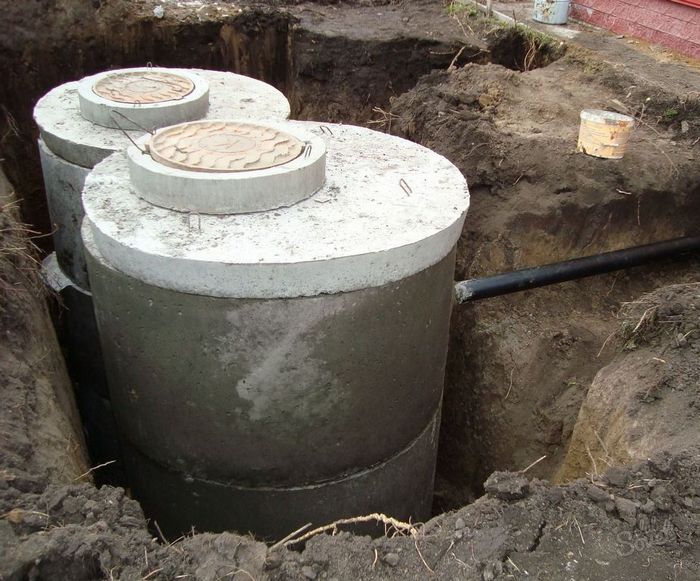
Making a septic tank from concrete rings with your own hands is quite simple, but first you need to decide how many chambers will be in your structure. You can make the following suburban septic tank from concrete goods:
- Single chamber product Is a reservoir for collecting sewage. A correct single-chamber septic tank should have a multiple of the daily discharge. The design can be carried out without a bottom. A single-chamber installation scheme does not imply the device of a drainage layer at the bottom of a structure made of reinforced concrete rings. The effluent is purified by soil filtration. As the soil becomes silted with heavy fractions, the efficiency of the treatment plant decreases.
Important: sewage should not seep through the joints of the well rings in a single-chamber septic tank.
- Two-chamber cleaning product... The device, consisting of two cameras, is more functional. In the first compartment-settling tank, heavy components of wastewater settle to the bottom, pre-purified settled water enters the second chamber. In this compartment, a drainage layer of sand and gravel is arranged at the bottom, through which the waters go into the ground. A septic tank with two chambers has the following operating state: the first chamber is always filled to the overflow level, the volume of effluent in the second chamber depends on the filtration rate and the volume of discharge.
Attention: the bottom of the filter well should not be built on clay soil, which has poor permeability. Construction is best done on sandy soils.
- Three-chamber septic tank made of reinforced concrete rings - the most perfect device from the point of view of correct waste disposal. The first two wells are sedimentation tanks where mechanical wastewater treatment is performed. The third compartment is a filter well. Such a septic tank for a summer residence has the following operating condition: the first two chambers are filled before overflow, and in the third compartment there is a small amount of water.
The construction of septic tanks without a bottom is allowed in two cases:
- With a low location of groundwater. In this case, the likelihood of effluent entering the aquifers is completely excluded.
- If it is required to provide water filtration into the ground. In this case, a sand and gravel filtration layer is made at the bottom of the structure.
To significantly speed up the process of decomposition of organic waste, you can build a septic tank with aeration. For this, a special device is used - a compressor with a timer, which injects air into the second chamber under pressure. As a result, the activity of aerobic microorganisms is activated, which decompose ammonia into nitrites.
Wastewater treatment plant without pumping

This name of the treatment plant is rather arbitrary and does not mean that it is not at all necessary to pump out sludge from the septic tank. However, with the right device, you will have to do this much less often. For example, such structures are known in the country, from which the sediment has not been pumped out for 10 years in a row.
In fact, this is a three-chamber structure, where in the first compartment the solid waste is processed by anaerobic bacteria without air access. Here the solid components are decomposed by microorganisms into hydrogen sulphide and methane, therefore a small silty sediment is formed. The better the decomposition process is, the less sediment is formed at the bottom.
For the efficiency of such a septic tank, you will need to equip the aeration of the second chamber with your own hands. Here, aerobic microorganisms will process the organic constituents of the effluent. They need oxygen for their vital functions, so a compressor is needed.
In the third chamber of such a unit in the country, it is necessary to equip a high-quality filter at the bottom so that the final filtration of pre-treated wastewater takes place. As a result, a minimum of sediment will form, and you will not need pumping soon.
Choosing a place for a septic tank
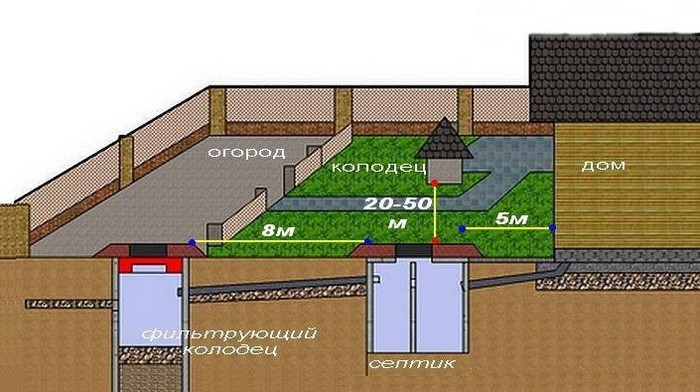
The place for the treatment plant is selected in compliance with the following rules:
- From the septic tank to the well or well, there must be at least 30 m.
- On the terrain, the treatment product is installed lower down the slope than other structures.
- It is worth retreating at least 5 m from the foundation of a residential building to the treatment plant.
- From open reservoirs to a septic tank should be at least 10-15 m.
It is also worth remembering that the sewer pipeline is laid with a slope from the house to the septic tank. At the same time, for each meter of length, the slope is 2 cm.The trench for the pipeline is dug at a depth of 0.9-1 m.
Installation
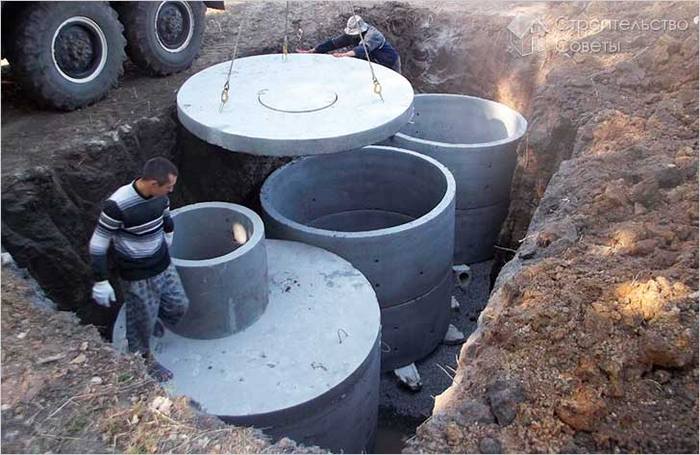
The video at the end of the article clearly shows the septic tank device. If you decide to make a sewage treatment plant from reinforced concrete products with your own hands, then its construction is carried out in the following sequence:
- A pit for a septic tank can be dug with a shovel or using construction equipment. In this case, the dimensions of the pit should slightly (by 20 cm) exceed the dimensions of the rings.
- Now you need to prepare the base at the bottom of the pit for the concrete rings. You can lay a factory concrete slab or make a base from monolithic concrete... For this it fits reinforcing mesh with cells of 20x20 cm, laid on the bottom and poured with concrete with a layer of at least 20 cm. Moreover, the concrete base can be made under each of the wells or be common for all chambers.
- Now reinforced concrete elements are installed on the prepared base. After the construction of the well, holes for the pipeline and tees are marked and punched in its walls. To do this, you can use a grinder and a hammer drill.
- Further, connecting pipelines are installed between the wells and a drain pipe is connected.
- We carry out waterproofing of concrete rings. For these purposes, the outer surface must be coated with liquid polymer mastics, bituminous composition or liquid glass. Also for these purposes, you can use a special concrete mixture with additives that will make the rings waterproof. The seams between the elements are filled with special care.
- Installing the covers over the cameras. In this case, the covers above the first and second sedimentation tank must have hatches for removing sediment.
- Now we are building ventilation. To do this, in the lid above the second chamber, set ventilation pipe, towering 50 cm above the ground.
- On this stage backfilling can be performed. The soil is filled up between the walls of the pit and the structure and rammed every 20-30 cm. The cover is covered with soil so that the hatch is on the surface.
Maintenance of a treatment plant made of reinforced concrete rings is reduced to monitoring the level of waste liquid in all chambers. If necessary, clean them.
Video about the device of a two-chamber treatment plant made of concrete rings:
Construction technologies are constantly evolving, it is not surprising that now you can make a septic tank from concrete rings with your own hands with minimal cost. The construction scheme is not particularly complex and allows you to create a solid and reliable structure without special knowledge.
Nevertheless, you need to know some of the nuances and follow the instructions exactly so that the structure will serve you faithfully for many years. Therefore, if you are interested in how to make a septic tank from concrete rings with your own hands, in this article you will find instructions with a detailed list of works, as well as construction diagrams.
What are septic tanks?
Before proceeding to the construction of a septic tank from concrete rings with your own hands, you need to decide on the type of construction. In reality, there are many. Depending on the principle of operation, the following types are distinguished:
- Accumulative. Imagine a system that works on the principle cesspool... The structure consists of two wells in which waste is separated into liquid and solid parts. So that the containers do not overflow from them, it is periodically necessary to pump out sewage. This scheme is suitable for summer houses. Pumping can be done once a year if you only come to the cottage for the weekend.
- Filtration. These septic tanks also consist of concrete rings, but they are more complex designs that have much more options. Inside, the sewage is separated into fractions, then, by filtration, the waste enters the soil. This technology can be used in homes where people live. The only drawback is the complicated installation.
- Septic tank made of concrete rings with a biological treatment system. This is one of the most advanced technologies that provides the highest level of cleaning. Moreover, this design allows, after cleaning, to drain waste into water bodies without harming nature. Anaerobic bacteria are placed inside the container, which decompose organic matter. Cleaning is carried out every 5-7 years.
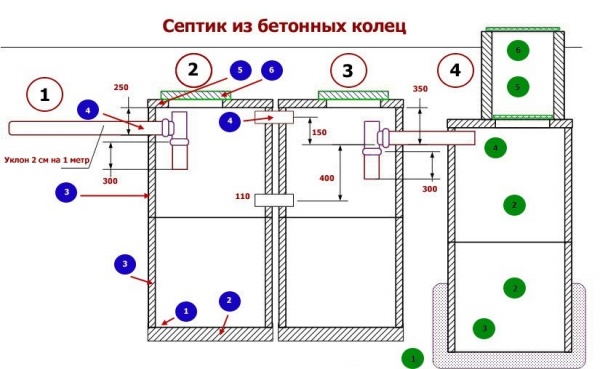
If we talk about cost, then the option with cesspool will be the least expensive. Nevertheless, it has many disadvantages. First, the cesspool needs to be cleaned periodically, which is not a great pleasure. Secondly, the unpleasant smell will be in the toilet all the time. The only salvation is special chemicals that allow you to overcome it.
The most environmentally friendly and practical is a septic tank made of concrete rings with a bio-purification system, however, its construction is not only a costly enterprise, but also complex. Nevertheless, the long service life without cleaning and the ease of use pay off all the difficulties.
Perhaps the best option is a filtration septic tank made of concrete rings. It is moderately difficult to build, but it has high reliability and a rather long service life without cleaning.
Classification of septic tanks according to the number of chambers
The more chambers in the septic tank of concrete rings, the better. In modern construction, only three design options are used:

Installing a septic tank
Installing a septic tank is a technically simple procedure that requires care and strict adherence to instructions. The installation process consists of the following steps:
- choice of location,
- preparation of the pit,
- installation of concrete rings,
- pipe installation,
- sealing joints,
- laying of floors.
The final stage of the work is filling the well with sand. Before you start construction works a project is drawn up, and calculations are made. The number of chambers is selected depending on the amount of waste. The same applies to the principle of work.
According to current building codes, a septic tank made of concrete rings should be located at a distance of five meters from residential buildings. At the same time, at a distance of 50 meters, there should not be any reservoirs and sources of water supply (this does not apply to structures with a biological treatment system).
Important ! These drainage systems are not recommended to be erected in places with low level groundwater.
Installation
During installation, it should be taken into account that groundwater should be located at a distance of at least one meter to the rings. A pit is dug at the place designated in the project. Moreover, its diameter should be larger than the concrete rings, but not much.
Important ! The gap is needed for laying the waterproofing layer.

Many novice builders pay too much attention to the shape of the pit. In reality, it can be either round or square. This does not particularly affect the process of further installation. However, a square pit is more convenient for placing a concrete slab. If you are going to do a screed, then the shape does not matter.
Sand should be poured into the pit with the expectation that the thickness of the sand layer should be about 30 centimeters. Only after this is the screed or concrete slab laid.
Important ! Before laying, the concrete slab must be pre-treated with cement mortar.
The rings go down inward one at a time. The joints are sealed with cement. Particular attention in the process of installing a septic tank from concrete rings should be given to pipes that will come out of the rings. They must be treated with special insulating material.
Important ! Cement is not suitable for pipe insulation. A material that does not crack when compressed is required.
The fact is that over time, a septic tank made of concrete rings will shrink. Naturally, this will have an extremely negative effect on the cement pipe insulation. To avoid depressurization use silicone grease.It will provide reliable and durable tightness of the entire structure.
When installing the filter rings, you need to do some additional manipulations. First of all, wells are drilled in the bottom of the well chamber, which will go one meter deep, this is clearly seen in the diagram.
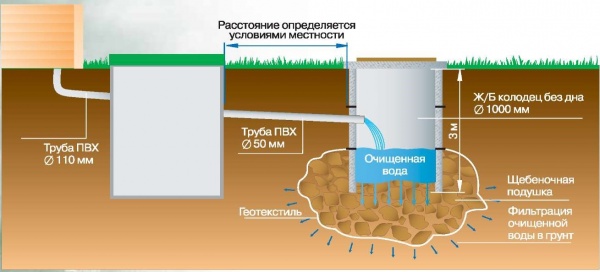
Pipes are placed inside the wells. It is best to choose plastic as a material. It is invulnerable to corrosion, due to which the service life of such pipes reaches 50-100 years. Rubble is poured inside. This is necessary so that organic deposits do not form on the walls.
The laying of the waterproofing layer is of particular importance. So that everything goes as it should, the concrete rings of the septic tank are coated with clay from the outside. But this is certainly not enough. The inner surface is also subject to processing. It is best to use bitumen mastic or water glass solution.
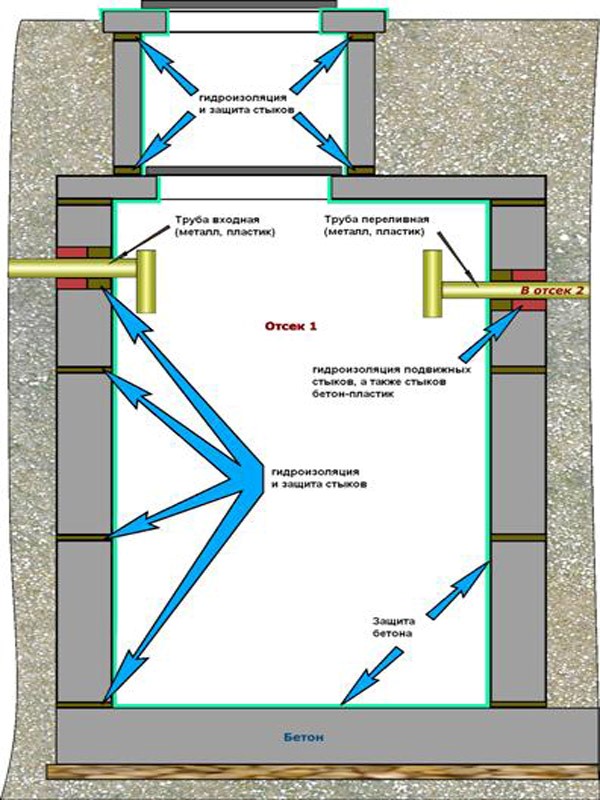
It is especially necessary to process the joints between the concrete rings of the septic tank. For this job, polymer mastics are well suited. For example, "Hydrotex" or "Hydroizol".
There must be good ventilation in a septic tank made of reinforced concrete rings. During its design, you should focus on two tasks: ventilation and air discharge in the sewer pipes.
In the traditional scheme, the drain pipe is connected to a ventilation riser. The conclusion is made on the upper floor of the septic tank. When designing, it is very important to correctly calculate the diameter of the riser pipe. You need to focus on the pipe connecting the septic tank with the building's sewage system. It is believed among construction experts that the optimum hole diameter is 110 mm.
Important ! If the cross-section is not large enough, the water flow will block the gap.
At the end of all work, a cover is installed on a septic tank made of reinforced concrete rings. Alternatively, consider a plastic manhole cover. It is a slab and has an aesthetic appearance.
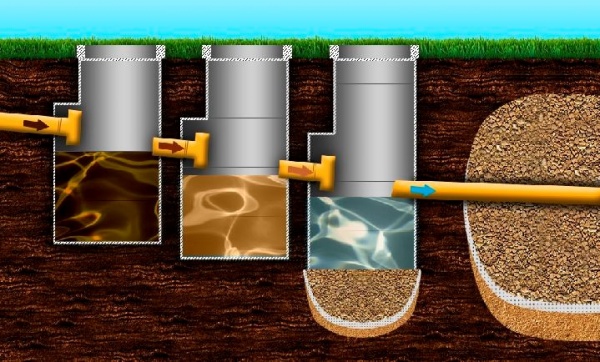
Every year the popularity of country septic tanks made of concrete rings is only growing. It is not surprising that the builders have developed a number of recommendations that allow you to increase the service life, and make the structure as reliable as possible, among the most important:
- It is recommended to install a ventilation pipe on each container.
- Laying concrete rings of a septic tank without the help of modern technology is an overwhelming task. Therefore, before starting construction work, take care of renting the appropriate equipment.
- To increase the strength of the entire structure, the concrete rings of the septic tank can be fastened with metal brackets.
- Septic tank covers must contain hatches. Structures must not be concreted tightly!The hatch is needed in order to check the internal state of the building from time to time.
Outcome
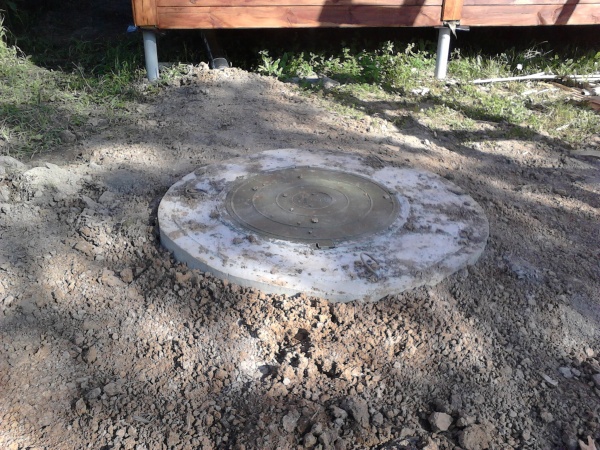
A septic tank made of concrete rings is easy to build with your own hands. In this case, you can choose both a simple and a complex design. The most modern structures make it possible to mount containers in the immediate vicinity of water supply points. It's all about the unique cleaning systems and anaerobic bacteria that recycle waste.
If funds are not enough, you can choose more economical options like a filtration septic tank made of concrete rings. The number of underground tanks in a filtration septic tank ranges from one to three. The more, the better the filtration.
When building a house, it is planned to lay a water supply system and sewerage lines. If in your area there is no centralized sewage system (summer cottages, country houses and private houses), the installation of a special device for drainage, filtration and purification of domestic wastewater is considered - a septic tank. This is a treatment plant that will make life easier for the owners and keep the environment from pollution. Before designing, you should study the soil at the installation site, calculate the estimated amount of drains and choose a septic tank that suits you from a variety of varieties, and also draw a diagram of a septic tank from concrete rings with your own hands.
Varieties of septic tanks
Traditionally sewage treatment plant it is customary to classify according to the following criteria:
- kind of work;
- material of manufacture;
- location of containers.
Let's consider them in more detail.
Features of septic tanks by type of work.
Septic tanks by type of work are selected depending on the daily amount of wastewater. They are:
- Cumulative... This is a cesspool type sump. All waste is collected in the well before filling. Cleaning is carried out with the help of sewage disposal equipment 1 time in 2 - 3 months. Such structures are best used in places with a small amount of drains, for example, in the country.
- With soil post-treatment... This septic tank is used in places of permanent residence and a large number of drains. It works on the principle of separation into fractions and consists of two chambers. In the first, large waste is retained, and in the second, the incoming water is purified with the help of special bacteria and discharged through the filtration fields into the soil. Such a septic tank requires cleaning once every 2 to 3 years.
- With deep biological treatment... Such a structure produces almost complete water purification. The principle of operation of such a septic tank in the separation of wastewater into light and heavy fractions, and then water is purified using bacteria and aerators. At the last stage, the water is disinfected using chemicals, so it can be used for irrigation or discharged into a reservoir. Its peculiarity is its connection to the mains. In such a septic tank, very little unprocessed waste remains, therefore, sewage equipment can be used once every 5 to 8 years.
The choice of a septic tank by material of manufacture
Septic tanks can vary in material of manufacture. For instance:
- Plastic and fiberglass. Good tightness, low weight and corrosion resistance make it possible to install without special equipment and guarantee a long service life. Not suitable for soils with close sewage.
- Brick. This is the availability of materials, easy installation, but requires additional tightness.
- Reinforced concrete. Reliable and durable construction. Suitable for moving soils.
- Metal. Not the best choiceas it is subject to corrosion.
Characteristics of septic tanks for the location of containers
Depending on the location of the tanks, there are vertical and horizontal septic tanks. The horizontal requires a large installation area, but it can be installed in case of close proximity of groundwater. And the vertical one is installed in standard conditions.
Features and benefits of a concrete septic tank
![]()
A concrete septic tank is one of the simplest and most economical ways to drain the sewer. This design very reliable and durable, does not require an electrical connection and will not rise under the influence of sewage. A concrete septic tank can be like monolithic construction, and is assembled from concrete rings.
The advantages of a concrete septic tank:
- Sustainability... Better wastewater treatment is carried out, and good sealing will protect against soil pollution with household waste.
- Durability... Unlike metal and plastic containers, reinforced concrete structure more resistant to environmental conditions (suitable for any soil).
- Profitability... The design of such a well is simple, available for installation by a non-professional. Low material and installation costs. There is no need for frequent call of sewers.
- Size selection... It is possible to install a sump of any height and diameter, depending on the need.
- Reliability... The concrete structure is reinforced with metal rods and can withstand any load. It is not prone to destruction and, due to its high weight, withstands the movement of soil and sewage.
- Autonomy... Does not require an electrical connection and installation of pumps.
Scheme of a concrete septic tank

The concrete septic tank consists of several sections. Usually, a septic tank scheme made of concrete rings is 2 or 3 wells interconnected, each of which performs a specific function. Consider the most common design of 3 wells.
The first well (storage) is intended for the accumulation of solids and must be with a concrete bottom to prevent sewage from entering the ground. It separates waste into solid and liquid particles. The solid part precipitates and remains in the first section, and the liquid part through the connecting pipe enters the second well (filter).
The second and third sections may be slightly smaller than the first or the same size as it. Secondary wastewater treatment takes place in the second well, after which it enters the third reservoir (drainage well). From here, the liquid is discharged into the soil through a drainage pad at the bottom, or is pumped out using a pump. In the design of 2 sections, the second well is excluded, and the function of cleaning and drainage is performed in the third.
Installation of a concrete septic tank
Correctly making a septic tank from concrete rings is not so difficult. To install a cleaning system of this type, you need to choose a suitable place, taking into account the location of groundwater (not closer than 1 m) and provide free access to sewage equipment. For installation, a pit is dug slightly larger than the size of the rings. The first well is placed on a concrete slab or the bottom is filled with concrete on site. A pipe from the house is brought to it along a slight slope. The rings are fastened together with cement or special metal plates to avoid shear during operation. The seams between the rings and the pipe inlet are carefully sealed. For this, silicone grease, liquid glass or special mastic are used. The second and third wells are mounted according to the same principle, only the second also has a concrete bottom, and in the third, a cushion of sand and gravel is poured onto the bottom. The tanks are interconnected by pipes with a diameter of 50 mm, each of which is placed 200 mm lower than the previous one.
Tip: To ensure the normal functioning of the septic tank in winter, protect the well from frost and create a suitable environment for bacteria to work, you should insulate the sections with expanded polystyrene, foam or any biofuel.
At the final stage, hatches are installed and the wells are covered with earth.
Price of a septic tank made of concrete rings
The cost of a concrete septic tank device includes the price of concrete rings, materials for hydro and thermal insulation, sand, crushed stone, cement and other materials. Due to the large weight of the structural elements, special equipment will be required for lifting the rings and an excavator for digging a pit. You will also need to pay for the work of the construction team, if you do not plan to do the installation yourself. But even taking into account all these costs, such a septic tank will come out cheaper than a ready-made factory design made of plastic. Therefore, calculate the budget for installing a septic tank and make your choice. More accurate prices for materials can be found on the Internet on sites for the sale of building materials.



